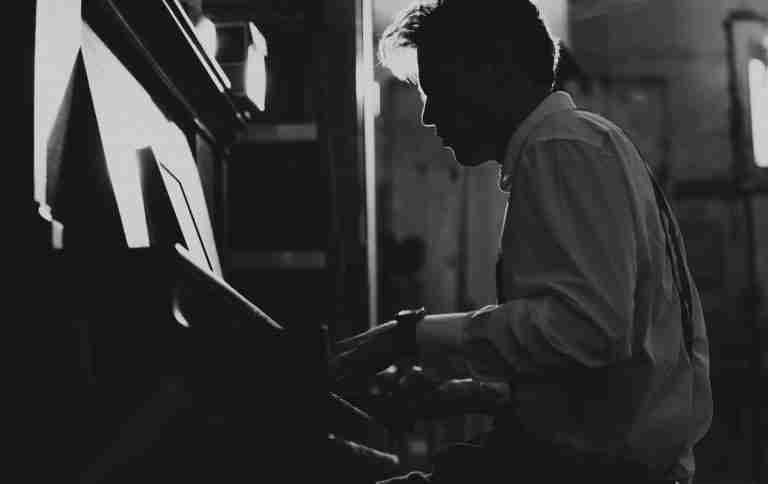From the moment we are born, the world tends to have a container already built for us to fit inside: A social security number, a gender, a race, a profession, an I.Q. I ponder if we are more defined by the container we are in, than what we are inside. Would we recognize ourselves if we could expand beyond our bodies? To be authentically ‘un-contained’ would we still be able to exist? – Paige Bradley
Music is sound.
We take in this sound with our ears and produce sound on our instruments.
Everything that you need to know about improving as an improviser originates from these two phrases. When you approach improvisation with the big picture in mind the entire process becomes much simpler. Coming to this realization can even change the way you improvise today.
Now I know what you’re thinking…”So I don’t have to worry about those scales, chords and theory ever again?” Not exactly.
You need to know your chords and scales, but you mustn’t stop there. Your creativity shouldn’t be limited to music theory alone, however this is much easier said than done. In the practice room analyze each chord, learn the names for each scale degree, and learn the rules for creating melodies and chord progressions, but when it comes to performing strive to move past the theory.
Remember, in the end music theory is just a method to describe sound with words. No matter what you’re thinking when you create your music (scales, chords, patterns, theory) everything is still experienced as sound by the listener.
This idea applies to any style of music from jazz to classical to the songs you hear on the radio everyday – it’s all sound. The composer Arnold Schoenberg states this idea succinctly in his “Theory of Harmony”:
The material of music is the tone; what it affects first, the ear. The sensory perception releases associations and connects tone, ear, and the world of feeling. On the cooperation of these three factors depends everything in music that is felt to be art.
Tone, ear and feeling – this is what it comes down to! When you improvise the listener doesn’t know what you’re thinking, but they can definitely tell what you’re feeling.
Getting stuck in the terminology
Music is a physical entity that exists in sound waves, not an intellectual theory that exists only in your mind.
For many of us the barrier with music theory starts at the very beginning. The first time that we attempt to improvise over a chord we’re given a scale on a piece of paper, eight notes to create a musical statement with. From that point on, if we don’t strive to include our ears, we’ll see music through the looking glass of scales and theory.
Improvising quickly becomes an intellectual puzzle rather than an expressive art form. We spend the majority of the time thinking about and describing these sounds without actually getting down to business and dealing with the sound itself.
The more we cling to theory the more we get stuck inside of our heads, and the more we rely on thinking through these chords and scales, the further we move away from the sound. Soon we’ve unknowingly erected this thick mental barrier between ourselves and the music. Before we hear a melody, chord or progression we have to think through the theory.
Over time we’ve made up a lot of words to describe sound (Minor 7 b5s, the sharp #11s, the “and” of four, iii-VI-ii-V, lydian, tri-tone subs…) and some people understandably get lost in the terminology. This is where the questions start coming in “What scale do I play here, which chord tone do I start on, how do I connect these guide tone lines, what is that chord called…??”
A work of art that contains theories is like an object on which the price tag has been left.~Marcel Proust
Theory is necessary in that we need a way to describe and visualize sound, however the problem arises when we rely solely on the terminology to create a solo. Learn the terminology and theory, but don’t be chained to it or limited by it.
If you want to see some meaningful improvement in the way that you improvise you need to get back to the sound of the music. You know your major and minor scales and you know the names and rules for theory, but let’s go back and start fresh. Let’s learn the “sound” of those chords.
The tools of your trade
Music theory is a tool that we use to visualize and verbalize the sounds we are interacting with as musicians. Scales are a tool. Inversions, arpeggios and patterns are tools. Even the names of intervals and notes are tools. These tools are knowledge that you’ve acquired and skills that you’ve developed in the practice room and you’ll use them as you create music in the moment.
However, tools in and of themselves don’t create great artistic inventions, people do.
Take a sculptor for instance. Does a sculptor think about her chisel or hammer as she starts a project? Does she wonder what her file is doing every step of the way? Not at all, she simply uses these tools to accomplish her task. What she does think about is shaping that piece of raw material and how it will fit into her vision of the finished product.
The same is true of a scale. When you’re improvising, you shouldn’t be thinking about the individual notes in a chord or a scale, you should instead be using these musical tools to create the sounds you’re hearing in your head. A scale is just one tool to access a sound, but a chord has many different possibilities besides those 8 notes ascending in order.
You can use that same scale in thirds, fourths or fifths. You can apply language that you’ve transcribed from your favorite players. You can even use melodic fragments or patterns that you’ve practiced. These are all tools that you can use over that sound.
To be a successful improviser you need to learn how to use your musical tools. Keep in mind that a tool is only as good as the person wielding it. As an improviser your theory and instrumental technique must be automatic, ingrained to the point of subconscious mastery. If you aren’t adept at using your tools you won’t be able to build anything.
Five sounds
One encouraging fact when you’re learning standards is that there aren’t that many sounds to learn. There are basically 5 chords that you need to master in all keys: Major, minor, V7, minor 7b5, and altered dominants. You do this and you’ve got 90% of the chords covered that you’ll find in the Great American Songbook.
You can count them on your fingers! Spend time mastering these sounds and you’ll have a great foundation as an improviser. However, mastering these sounds means much more than learning a few scales and arpeggios.
The approach is the same for major, dominant or minor chords or any other sound that you might encounter as an improviser.
For example, let’s start with a C Major 7 chord.
When you see a Major chord this is current method for learning how to play over this sound:
This scale is the one tool we have for playing over a Major 7 chord, a mental picture of 8 notes in ascending order. But how do those 8 notes become this?:
When you come from the mentality of scales it seems like magic. This is the first obstacle a lot of improvisers run into, they are trying to play every musical idea with these 8 notes in order. This type of thinking is confined in a box, anything outside of it seems impossible.
It could be a standard, a vamp, a ii-V-I, a single chord – everything is mentally confined to that scale.
To truly explore these sounds and break out of the theory box you must approach these chords in a different way than the 1 scale /1 chord approach. Below are two key areas in overcoming the theory barrier: Technique & Language.
Technique
Technique is the tool that allows us to express our inner sound. It’s necessary to play an instrument, but at its most it is only a means to an end. Technique and theory enable you to play what you’re hearing and allow you to access these sounds more easily. However, technique and theory alone cannot make a great improviser.
Those exercises (scales, arpeggios, and scales in thirds) that we all practice everyday are just exercises. You do them so your fingers are ready to play anything that you hear, so you can play your instrument in the most efficient manner possible, but they are not going to turn into great improvised lines by themselves.
Ultimately, you ingrain technique so you can focus on music when you play, not the mechanics of playing your instrument.
Here are a few resources to check out as you practice your technique:
- How to practice your scales
- Practicing in all 4 directions
- Jazz articulation for horn players
- 4 ways to reinvigorate the practice of technique
- 3 steps to freedom in all 12 keys
Developing solid technique is essential in overcoming the mental barrier of music theory.
The theory of scales, chords and arpeggios should be ingrained in your fingers at a physical level, not just a mental level. Technique includes ear training, scales, mastery of all 12 keys, articulation, time/rhythm. Without these skills, the only way to access these chords will be through music theory, you’ll be an artist trying to create a work without the necessary tools.
Language
The next step to overcoming the barrier of music theory is learning language, i.e. transcribing. If technique is the tool that allows you to move past music theory, transcribing language is the process of discovering the musical possibilities available on every chord.
When you learn a musical phrase you start thinking about bigger chunks of time. Instead of individual notes in a chord you’ll start to hear lines and phrases. Just as when you speak you don’t focus on individual words, in improvisation you don’t want to focus on individual notes.
The process of learning language also has some important benefits to overcoming the barrier of music theory. The underlying process in transcribing is imitation – repeating what you hear solely by ear. As you transcribe you’re not coming from the mentality of chords and scales, you’re focusing directly on the sound.
Pick out some solos by your favorite players and start learning some language. Take one phrase over one chord and ingrain it in your fingers and your ears. Learn it in all 12 keys. Now you have something to play that isn’t based on music theory or the notes of a scale – it’s sound.
Technique + Language = The building blocks of improvisation
To successfully complete any task you need to develop certain key skills and have an internal model of the finished product in your mind. For example, if you wanted to write a novel you would need control over the technical aspects of writing (vocabulary, sentence structure, form) as well as a knowledge of what great writing looks like (reading great writers and important novels).
The process is the same for improvisation. To play a great solo you need to develop instrumental technique and a solid base of theory knowledge, but you also need to know what good phrasing and melodic construction sounds like (listening and transcribing solos).
Once you have some technique and language, you’ll be well equipped to deal with the sound of music itself. With a solid base of technique and language you won’t be limited by the basics of music theory, you’ll be able to move beyond it.
Before you might have had one scale to play over a Major 7 chord, one option on every tune, but with a little technique and transcribing many musical possibilities start to open up. Instead of thinking through the chord progression you are now hearing lines to play and your fingers will intuitively know where to go. Now you are improvising as opposed to picking notes out of a scale.
Breaking out of the container
Right now you may feel stuck in the theory box, trapped with no way to get out. Improvising may be a whirlwind of scales and chord names and every time you try to solo it’s a headache.
No worries. This is simply a sign that you need to go back to those scales and brush up on your technique and that you need to start transcribing some musical language.
As you start working on your repertoire, you may feel creative on some tunes, but stuck with scales and theory on others. The better you know a tune, the less you’ll have to rely on the theory to get by and the more foreign a tune the more you’ll be cognizant of the chords and scales. More practice and more familiarity equals more musical freedom.
Above all, remember that sound should be explored. You should learn the rules, but strive to find your own sound. If everyone followed the rules of music theory to the tee we wouldn’t hear anything new year after year. Know the rules inside out and then break the rules.
The irony in dealing with music theory is that the less you’ve studied it the more you’re going to be limited by it. You’re stuck in the box if you only know one scale or one lick. On the other hand, the players that have spent hours mastering theory and technique are able to free themselves from scales and chords and the mechanics of the instrument.
In a way you have to start in the box and then work slowly day after day, hour after hour ingraining the basics until one day, you eventually break free.













